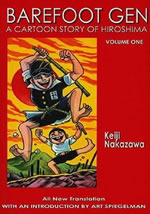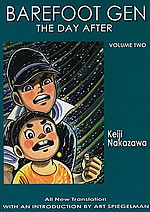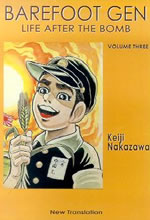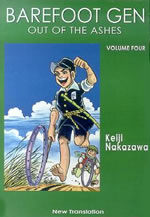Keiji Nakazawa:
Barefoot In Hiroshima

It was a Monday morning, 70 years ago. On August 6, 1945, the sun was shining. It seemed like just another ordinary summer day as six-year-old Keiji Nakazawa made his way to school. Looking up, he was surprised to see an American B-29 bomber flying over head. No air-raid warning sirens had sounded. 43 seconds later, a bomb nicknamed ‘Little Boy’ exploded 1,800 feet above him. In an instant, Keiji and thousands of other residents of Hiroshima were hit by an atomic bomb.
Mercifully no nation apart from Japan has had to endure atomic bombings and their insidious radioactive after-effects. This may explain why their shockwaves continue to reverberate in numerous manga and anime fantasies set in post-apocalyptic dystopias, from Akira and Nausicaa to Dragon Head and many more. Perhaps creating stories about this massive, unique trauma to a nation’s psyche offers one way to deal with these painful memories and their legacy.
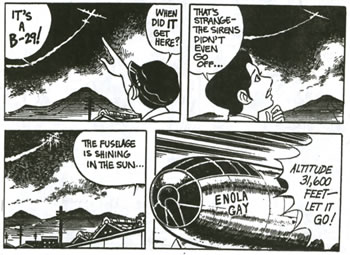
In Keiji Nakazawa’s case, only one mile from ground zero, he miraculously escaped with only minor injuries along with his pregnant mother. In the ensuing nightmare, his father, brother and sister were not so lucky, trapped under their burning house. Keiji was forced to grow up overnight and help his mother and new baby sister survive the horrors and hardships of a devastated, defeated Japan.

As a boy, it was a relief for him to escape into the first successful manga by Osamu Tezuka, the father of the post-war comics industry. Inspired by Tezuka’s 1948 Shin-Takarajima, or New Treasure Island, as well as by his late father’s artistry, Keiji soon showed real talent for drawing at school.
While working in his first job as a sign painter after graduating, Keiji started to sell cartoons and comics to manga magazines. In time, his commissions built up so that he was able to move to Tokyo in 1961, where he specialised in adventure and sports stories for boys. Back then, nobody in Japan spoke about being an A-bomb survivor, so Keiji learned to keep quiet about it in public. He never included anything about his childhood experience in his escapist manga.
That all changed after his mother died in 1966, When he went to the crematorium to collect her ashes, he found there were no bones left, as there normally are after a cremation. Radioactive caesium from the bomb had eaten them away. In a 2003 interview with Alan Gleason in The Comics Journal #256, Nakazawa remembered, "I was enraged that the bomb had taken even my mother’s bones. All the way on the train back to Tokyo, I couldn’t stop thinking about it. I realised I’d never thought seriously about the bomb, the war and why it happened. The more I thought it, the more obvious it was the Japanese had not confronted these issues at all. They hadn’t accepted their own responsibility for the war. I decided from then on, I’d write about the bomb and the war, and pin the blame where it belonged."
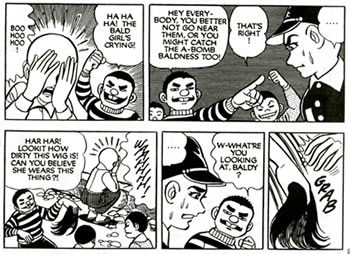
To vent his anger, Keiji began to talk about these issues through his manga. Initially, the larger publishers rejected his proposals for dark controversial post-war dramas, so he drew them for the new smaller circulation adult magazines like Manga Punch. But then Tadasu Ogano, an editor at Shueisha, publisher of the massively popular boys’ weekly Shonen Jump, invited him to draw a short autobiographical story. Out of this came Nagano’s offer to run an ongoing longer serial about his childhood in Jump.
Keiji created the character Gen Nakoaka as his largely identical alter ego and through him accurately recounts his experiences in Hadashi No Gen, or Barefoot Gen. It became a huge hit when it was serialised from 1972. It’s amazing to think that such a sensitive topic could be published in a comic for boys. Considering his outspoken criticism of Japan’s militarist regime and wartime propaganda, Keiji felt sure he would be the target of hate mail or threats, but he recalls, "Gen only got praise. Even the right-wingers cried when they read it!" Barefoot Gen went on to appear in other magazines accumulating ten volumes of over 200 pages each, and has been adapted into anime and live action movies, a musical and an opera.
Its powerful anti-nuclear and anti-war message, which were more overtly critical of the Japanese than of the Americans, led to it becoming the first book-length manga to be translated into English in 1978 by the small Tokyo-based non-profit volunteer group Project Gen. Two years earlier, several Japanese peace activists had joined a Transcontinental Walk for Peace from coast to coast across America. En route, they showed American marchers a copy of the Japanese book of Barefoot Gen, who urged them to put it into English. Back in Japan, they set to work and eventually translated the first four volumes.
Every few years, Barefoot Gen finds fresh audiences. After the success of Maus, Penguin reissued the first two volumes and later, amid the tide of manga sweeping the globe, Nakazawa’s masterpiece was released in a brand new edition, re-lettered and newly translated. San Francisco’s Last Gasp went on to complete the whole 10-volume series.
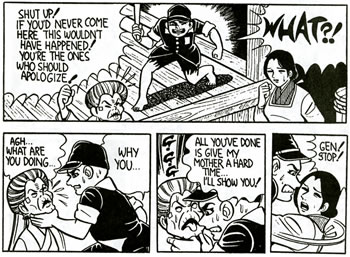
It is intriguing to speculate whether such a critical, heavily politicised series as Barefoot Gen could see print today in Japan’s multi-million-selling magazines. The climate is different and right-wingers have recently succeeded in pressuring Shueisha, the same publisher that launched Gen, to censor and suspend a manga story about Japan’s military records.
You may have heard about the recent anti-Japanese protests in China, sparked in part by the Japanese governments’s approval of some new school history textbooks by right-wing authors, who omitted any reckoning of the numbers of Chinese sexually abused and killed by the Japanese army in the notorious 1937 Rape of Nanking. They also completely removed any mention of the many Asian ‘comfort women’ used as sex slaves for Japanese troops.
In October 2004, publishers Shueisha received many complaints about a historical serial in Young Jump called Kuni ga Moeru (The Country Is Burning) by Hiroshi Motomiya, after he showed scenes of the Nanking massacre. Among the objectors was a group of 37 politicians who claimed that the depiction of the killings grossly distorted history. Specific objections concerned the authenticity of certain photos, on which Motomiya had based some of his panels. In a climb down, Shueisha dropped the serial and amended the offending images when it was reprinted in book form.
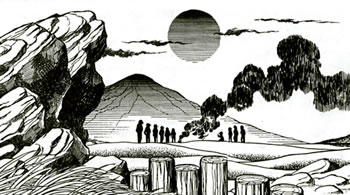
Keiji Nakazawa was adamant: "[Japan] experienced complete devastation in the last war, and yet ultra-nationalists are crawling out of the woodwork again, glorifying the war and trying to rewrite the history textbooks. And as usual they talk about restoring the emperor to his rightful position of absolute authority… That’s why I say we need to dismantle the whole imperial system." In the climate of nationalism and denial at that time, the repeated apologies by Japan’s then Prime Minister for his country’s war atrocities were perhaps not be enough to counter the official glossing over of the past.
The creator of Barefoot Gen died in 2012, but his masterpiece lives on, as animated and live-action movies and of course the original manga books. Last Gasp want to get hardcover editions of this important graphic novel into more schools and libraries in America (see video below). Nakazawa’s message remains as timeless and urgent as ever.
Posted: August 5, 2015
The original version of this article appeared in 2005 in Comics International, the UK’s leading magazine about comics, graphic novels and manga.













